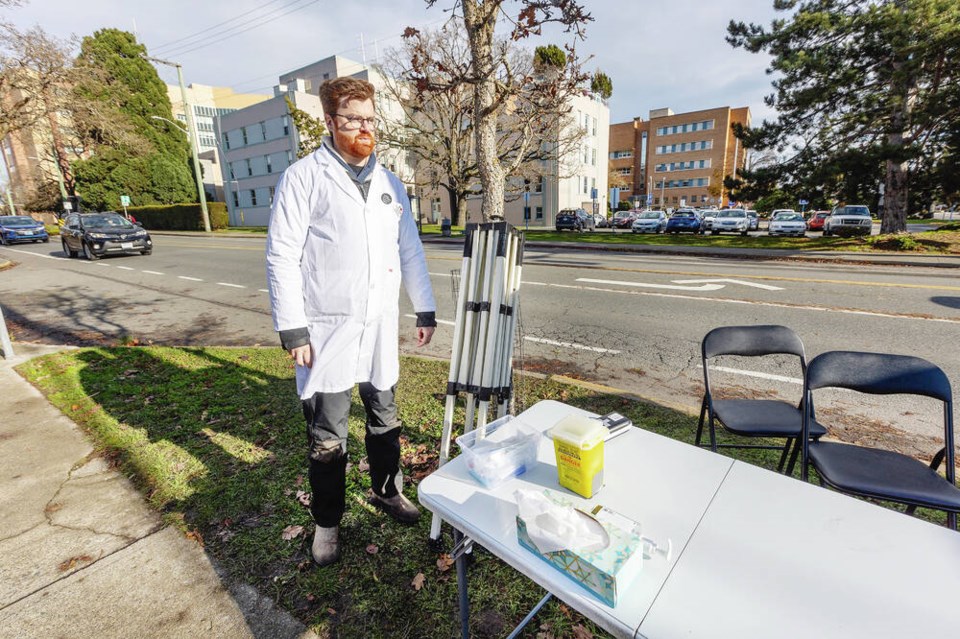The B.C. Nurses’ Union says it’s “disturbing” that physicians in Victoria and Nanaimo have had to take time away from their work and resort to erecting pop-up overdose prevention sites for hospital patients struggling with addiction.
Those services ought to be provided by the health authority, the BCNU said in a statement to the Times Colonist this week.
The BCNU, which emphasizes that it believes in harm-reduction practices for patients, has also supported nurses who have complained about walking through plumes of toxic smoke in hospital hallways as a result of a permissive attitude toward drug use in hospitals.
The issue became a political flashpoint in the spring, with nurses and patients complaining of patient drug use or possession in hospital rooms and halls.
An Island Health memo dated March 12 to acute-care hospital staff instructed nurses not to stop open use of illicit drugs in hospital rooms and to even teach patients how to inject drugs into their IV lines as part of a harm-reduction approach — despite the fact government officials said drug use is not permitted in hospitals.
Initially, the province’s then health minister indicated a review by a provincial task force would “ensure the use of drugs is specific to designated spaces within or around the facility.” Later, however, Adrian Dix emphasized no-smoking policies in hospitals, under criticism from the B.C. Conservative Party.
Victoria family physician and addictions medicine specialist Dr. Ryan Herriot, who helped run an unsanctioned overdose-prevention site across from Royal Jubilee Hospital from Monday through Wednesday this week, said Thursday he was thrilled to hear the endorsement from the B.C. Nurses’ Union.
“We want to solve this problem in the most ethical way for everybody involved.”
Herriot said that hospital-based addictions teams help many patients who have addictions and are in hospital for medical care — whether for illnesses or accidents — but for a segment of the population, it doesn’t work.
Herriot and colleague Dr. Jess Wilder — who is hosting a similar overdose-prevention pop-up site across from Nanaimo Regional General Hospital this week — argue that as doctors who work on those addictions teams, “we know what we’re talking about.” “The majority of the doctors involved in this [ protest ] are the ones who staff those teams,” said Merriot.
Wilder, who plans to continue to run the site across from the Nanaimo hospital until end of day Friday, said the site has accommodated 20 witnessed consumptions since Monday.
Wilder, the physician lead on an addiction-medicine consult team that includes a doctor and nurse, social worker and support workers at Nanaimo’s hospital, said the reality is the team can’t meet everyone’s needs.
“When we are using hydromorphone to try to keep somebody out of withdrawal from fentanyl, we are bringing a water gun to fight a forest fire,” she said.
Hydromorphone, called Dilaudid, is used as a safer-supply drug but is much less potent than the synthetic opioid fentanyl, which is similar to morphine but 50 to 100 times more potent.
Currently, the Vancouver Island Health Authority does not provide patients a safe space to use their drugs in Island hospitals, Wilder said.
Instead, it tells them they have to leave hospital grounds to use their substances, she said, “which means that they’re going to bus stops, and they’re going to the bushes, and they’re going to the shadows in this community neighborhood of the hospital.”
People who live around the hospital are having to respond to overdoses “and find people who have unfortunately passed away from a toxic drug poisoning,” said Wilder, who learned Tuesday of a patient who overdosed in the bathroom of the hospital’s emergency room.
Wilder said the sadness felt by her team — who got to know the patient well over the years — is “fueling us to continue to be here and to to keep fighting for the service that would have saved his life.”
Family physician and addictions specialist Dr. Patricia Caddy said health authorities need to provide a well-ventilated designated space in hospital to keep drug-using patients safe. She said such sites can be life-saving and provide a “bridge” to recovery services.
Caddy pointed to St. Paul’s Hospital in downtown Vancouver, which has an overdose-prevention site. “These services exist and are saving lives just a short ferry ride away.”
St. Paul’s Hospital has been criticized, however, by patients and families who say they have to walk through plumes of toxic drug smoke.
In response to complaints that overdose-prevention sites enable drug use, Caddy said that’s like saying that seatbelts enable speeding, or hospitals enable injury.
“Sites like these do not enable drug use — they keep people who use drugs alive one more day,” said Caddy. “And in a crisis like the one we are living in, that can make all the difference.”
Herriot maintains that addictions physicians have been “too quiet” over the past year of politics muddying the issue.
“There has been a certain type of pressure on this issue, and an absence of a different kind of pressure, and we’re trying to bring that different kind of pressure,” said Herriot, who wants the province to direct health authorities to create space at hospitals for medical patients who are addicted to drugs.
“Whether or not we see any action from the minister of Health this week, this is not the end of the story,” he said.
“I have no doubt that other groups of doctors across the province are looking to do the same thing, and we hope to assist them to the extent that we can.”
>>> To comment on this article, write a letter to the editor: [email protected]



